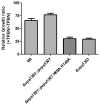Characterization of a novel zinc transporter ZnuA acquired by Vibrio parahaemolyticus through horizontal gene transfer
- PMID: 24133656
- PMCID: PMC3794297
- DOI: 10.3389/fcimb.2013.00061
Characterization of a novel zinc transporter ZnuA acquired by Vibrio parahaemolyticus through horizontal gene transfer
Abstract
Vibrio parahaemolyticus is a clinically important foodborne pathogen that causes acute gastroenteritis worldwide. It has been shown that horizontal gene transfer (HGT) contributes significantly to virulence development of V. parahaemolyticus. In this study, we identified a novel znuA homolog (vpa1307) that belongs to a novel subfamily of ZnuA, a bacterial zinc transporter. The vpa1307 gene is located upstream of the V. parahaemolyticus pathogenicity island (Vp-PAIs) in both tdh-positive and trh-positive V. parahaemolyticus strains. Phylogenetic analysis revealed the exogenous origin of vpa1307 with 40% of V. parahaemolyticus clinical isolates possessing this gene. The expression of vpa1307 gene in V. parahaemolyticus clinical strain VP3218 is induced under zinc limitation condition. Gene deletion and complementation assays confirmed that vpa1307 contributes to the growth of VP3218 under zinc depletion condition and that conserved histidine residues of Vpa1307 contribute to its activity. Importantly, vpa1307 contributes to the cytotoxicity of VP3218 in HeLa cells and a certain degree of virulence in murine model. These results suggest that the horizontally acquired znuA subfamily gene, vpa1307, contributes to the fitness and virulence of Vibrio species.
Keywords: Vibrio parahaemolyticus; fitness; horizontal gene transfer; virulence; znuA.
Figures









Similar articles
-
The mechanisms that regulate Vibrio parahaemolyticus virulence gene expression differ between pathotypes.Microb Genom. 2018 Jun;4(6):e000182. doi: 10.1099/mgen.0.000182. Epub 2018 May 29. Microb Genom. 2018. PMID: 29813014 Free PMC article.
-
Identification and characterization of a novel type III secretion system in trh-positive Vibrio parahaemolyticus strain TH3996 reveal genetic lineage and diversity of pathogenic machinery beyond the species level.Infect Immun. 2009 Feb;77(2):904-13. doi: 10.1128/IAI.01184-08. Epub 2008 Dec 15. Infect Immun. 2009. PMID: 19075025 Free PMC article.
-
Vibrio parahaemolyticus ExsE is requisite for initial adhesion and subsequent type III secretion system 1-dependent autophagy in HeLa cells.Microbiology (Reading). 2012 Sep;158(Pt 9):2303-2314. doi: 10.1099/mic.0.059931-0. Epub 2012 Jul 5. Microbiology (Reading). 2012. PMID: 22767546 Free PMC article.
-
Distribution and dynamics of epidemic and pandemic Vibrio parahaemolyticus virulence factors.Front Cell Infect Microbiol. 2013 Dec 11;3:97. doi: 10.3389/fcimb.2013.00097. eCollection 2013. Front Cell Infect Microbiol. 2013. PMID: 24377090 Free PMC article. Review.
-
Structure, function and regulation of the thermostable direct hemolysin (TDH) in pandemic Vibrio parahaemolyticus.Microb Pathog. 2018 Oct;123:242-245. doi: 10.1016/j.micpath.2018.07.021. Epub 2018 Jul 19. Microb Pathog. 2018. PMID: 30031890 Review.
Cited by
-
Zinc transporters YbtX and ZnuABC are required for the virulence of Yersinia pestis in bubonic and pneumonic plague in mice.Metallomics. 2017 Jun 21;9(6):757-772. doi: 10.1039/c7mt00126f. Metallomics. 2017. PMID: 28540946 Free PMC article.
-
The Yersinia pestis siderophore, yersiniabactin, and the ZnuABC system both contribute to zinc acquisition and the development of lethal septicaemic plague in mice.Mol Microbiol. 2014 Aug;93(4):759-75. doi: 10.1111/mmi.12693. Epub 2014 Jul 16. Mol Microbiol. 2014. PMID: 24979062 Free PMC article.
-
Nutrient Zinc at the Host-Pathogen Interface.Trends Biochem Sci. 2019 Dec;44(12):1041-1056. doi: 10.1016/j.tibs.2019.06.010. Epub 2019 Jul 17. Trends Biochem Sci. 2019. PMID: 31326221 Free PMC article. Review.
-
ZntA maintains zinc and cadmium homeostasis and promotes oxidative stress resistance and virulence in Vibrio parahaemolyticus.Gut Microbes. 2024 Jan-Dec;16(1):2327377. doi: 10.1080/19490976.2024.2327377. Epub 2024 Mar 11. Gut Microbes. 2024. PMID: 38466137 Free PMC article.
-
Comparative genomics of DtxR family regulons for metal homeostasis in Archaea.J Bacteriol. 2015 Feb;197(3):451-8. doi: 10.1128/JB.02386-14. Epub 2014 Nov 17. J Bacteriol. 2015. PMID: 25404694 Free PMC article.
References
-
- Ammendola S., Pasquali P., Pistoia C., Petrucci P., Petrarca P., Rotilio G., et al. (2007). High-affinity Zn2+ uptake system ZnuABC is required for bacterial zinc homeostasis in intracellular environments and contributes to the virulence of Salmonella enterica. Infect. Immun. 75, 5867–5876 10.1128/IAI.00559-07 - DOI - PMC - PubMed
-
- Bruland W. K. (1989). Complexation of zinc by natural organic-ligands in the central north pacific. Limnol. Oceanogr. 34, 269–285 10.4319/lo.1989.34.2.0269 - DOI
-
- Caburlotto G., Gennari M., Ghidini V., Tafi M., Lleo M. M. (2009). Presence of T3SS2 and other virulence-related genes in tdh-negative Vibrio parahaemolyticus environmental strains isolated from marine samples in the area of the Venetian Lagoon, Italy. FEMS Microbiol. Ecol. 70, 506–514 10.1111/j.1574-6941.2009.00764.x - DOI - PubMed
Publication types
MeSH terms
Substances
LinkOut - more resources
Full Text Sources
Other Literature Sources

